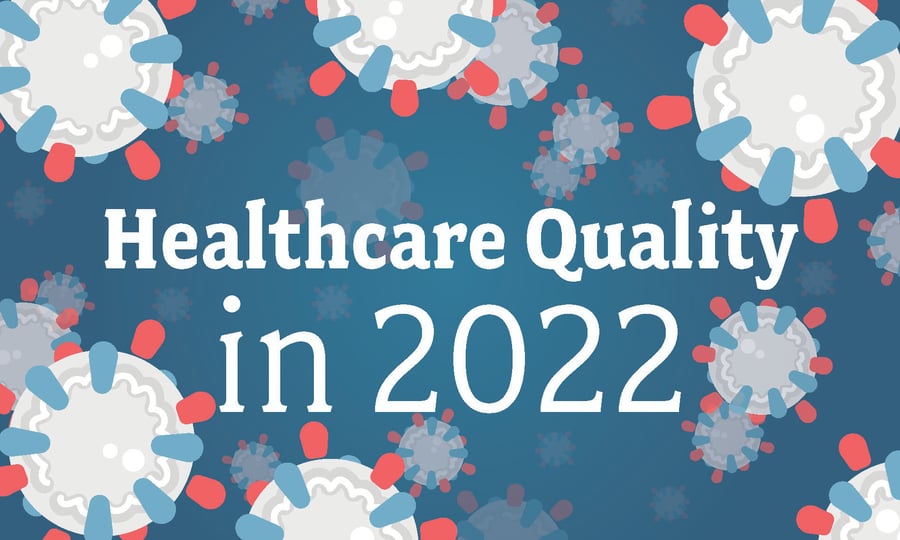A Note From Our CEO: The Quest for Healthcare Quality Continues in 2022

The COVID-19 pandemic is reshaping care delivery which is also impacting quality measures performance. How will that play out in the year ahead? What other trends will affect the work of quality leaders in 2022? Our CEO, Dr. Zahid Butt, shares his insights in this annual quality outlook.
A Note From Our CEO: The Quest for Improving Healthcare Quality through Measurement Continues in 2022

It would be impossible to talk about where quality improvement and quality measurement are headed in 2022 without first acknowledging the elephant in the room. That elephant, of course, is the COVID-19 pandemic.
COVID was not as disruptive to quality improvement and quality measurement in 2021 as it was when it first arrived in 2020. But it certainly continued to have an impact and will continue to do so this year.
COVID resets the baseline for quality performance
The pandemic has had a direct impact on how the industry collects and reports quality measures. Everything had, and will have, to be recalibrated. After the government declared COVID a public health emergency, most payers, including Medicare and Medicaid, and private accrediting agencies, including The Joint Commission, temporarily suspended or provided exemptions to some of their quality reporting requirements. Many healthcare providers stopped reporting quality measures, while others continued to collect and report quality measures as usual. CMS has excluded CY 2020 data from some measure calculations and as we head into 2022, additional resets of baseline performance numbers are very likely.
One could argue that COVID also affected the quality and safety of care generally even for non-Covid conditions—across the entire country in the first half of 2020, and in regional COVID hotspots after that. Providers will likely see an impact on the quality of care due to many factors including suspension of elective procedures, the growth in virtual care, fewer preventive health screenings and revised infection control protocols that limit patient contact. We’ve already seen a rise in healthcare-associated infections (HAIs).
Two quality-reporting do-overs
As for non-COVID quality developments in 2021, I believe that two will have a direct impact on quality measurement and reporting in 2022.
The first is the “strategy refresh” from the Center for Medicare and Medicaid Innovation (CMMI), which oversees all of the federal government’s value-based care and reimbursement programs. CMMI was right in deciding that provider participation was lower than it hoped for because there were too many programs. CMMI’s new goal of reducing the number of programs and focusing on those with a high probability of scaling is the correct path. That will have a direct impact on the workload and workflows of hospital quality departments possibly as soon as this year. Quality leaders will need to stay on top of which programs are scaling, which ones are being scaled back and which ones are being terminated.
The second development is CMS’ decision to delay by two years the planned sunset of its CMS Web Interface for reporting quality measures. The interface is an old-fashioned way of quality reporting, and CMS hoped to replace it with a set of three eCQMs starting in 2022. But after the agency learned that many accountable care organizations (ACOs) participating in the Medicare Shared Savings Program weren’t aggregating and reporting patient data from all their providers, it pushed that date back to 2024 to give ACOs more time to prepare for the transition. The responsibility for that preparation likely will fall on the quality departments at health systems participating in those ACOs as they are the most adept at collecting and submitting aggregated performance data and submitting it electronically either themselves or through partnerships with technology companies.
One additional COVID-related factor I haven’t mentioned yet is virtual care, though I believe that will live on long after COVID ceases to be a healthcare focus. We’ll see how it ultimately affects patient outcomes and how quality measurement will be adapted to this form of care delivery.
COVID, the big unknown in 2022
Now, let’s turn our attention to quality improvement and quality measurement in 2022.
Clearly, COVID isn’t going away. The Omicron variant, the longevity of vaccine effectiveness, vaccine hesitancy and the legal status of vaccine mandates are all factors keeping COVID’s ongoing impact solidly in the “Unknown” column. Will COVID just become an endemic thing we have to factor into everyone’s performance and reporting year to year? Or will it continue to be a big enough problem that we’ll need to deal with separately?
We don’t know yet how it will play out. Either way, quality leaders will have to stay ahead of COVID’s continuing impact.
Watch for more dQM guidance
Quality leaders should keep an eye on dQMs, or digital quality measures in 2022. As we discussed in a previous blog post, dQMs are any quality measure that can be calculated automatically from any standardized FHIR data source, not just the EHR, without manual human intervention. Under that definition, eCQMs are a subset of dQMs. As for CMS’ all-cause hybrid risk adjusted hospital-wide 30-day readmission and mortality measures, they won’t be mandatory for hospitals to report until 2023. Both are voluntary in 2022. I would hope that most hospitals will take advantage of the optional reporting period to get their data in good shape before these two new hybrid risk adjusted measures become mandatory and CMS posts the scores for all to see. We wrote about how to implement the hybrid readmission measure in this blog post.
CMS has said that it wants to transition all quality measures to dQMs by 2025. I think that date is aggressive given the complexity of the transition. Still, quality leaders should watch for more guidance from CMS on dQMs this year.
Opioid prescribing and readmission measures
The last item on my list for 2022 is the Opioid safe prescribing eCQM.
CMS started requiring hospitals to submit the new Safe Use of Opioids—Concurrent Prescribing eCQM (CMS 506) on Jan. 1. It measures a hospital’s share of its eligible inpatient population discharged with two or more opioid prescriptions, or an opioid and a benzodiazepine prescription.
CMS said it intends to make hospitals’ opioid scores public, starting with 2022 performance data. It will be interesting to see how much variation there is in hospital opioid prescribing practices nationwide. In a previous blog post, we published aggregate average and median scores from a subset of our hospital clients.
The potent combination of COVID unknowns, the ascension of dQMs and new publicly available measures of hospital performance is sure to keep quality leaders busy in 2022. The quest for quality, and how to measure it, continues.
As always, we at Medisolv stand ready to help in the new year and beyond.
_______________________________________________________________________________________________________________
To learn more about where we’ve been and where we’re headed in terms of quality improvement and quality measurement, please read more of our annual healthcare quality outlooks from Dr. Butt:






Comments